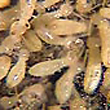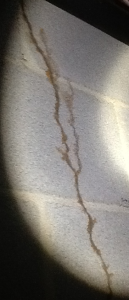 are under full attack from the Eastern Subterranean Termites and with colony sizes that will push well into the millions they are poised to win. Since termite attacks are hidden by design (eating the wood from the inside out and causing significant damage before they are discovered) it is critical to always be on the lookout for signs of termites and to have your home inspected regularly.
are under full attack from the Eastern Subterranean Termites and with colony sizes that will push well into the millions they are poised to win. Since termite attacks are hidden by design (eating the wood from the inside out and causing significant damage before they are discovered) it is critical to always be on the lookout for signs of termites and to have your home inspected regularly.
Tools for the Job
- Bright Flashlight
- Large Screwdriver
- Small Screwdriver or Pocket Knife
- Crawl Suit
- Bump Cap
- Knee Pads
 Inspect the foundation for Mud Tunnels. These shelter tubes are built by termites to protect them from predators and to help maintain the high humidity that they require. If your home has a basement or a crawlspace, you will need to inspect the interior of the foundation as well the garage. You will have to look very carefully because these tubes are often hidden in cracks and corners, and only become obvious after an infestation is many years old and significant damage has been done.
Inspect the foundation for Mud Tunnels. These shelter tubes are built by termites to protect them from predators and to help maintain the high humidity that they require. If your home has a basement or a crawlspace, you will need to inspect the interior of the foundation as well the garage. You will have to look very carefully because these tubes are often hidden in cracks and corners, and only become obvious after an infestation is many years old and significant damage has been done.
Step Two – Sound out and probe the wood. This is done to detect termites that are hidden deeper in the wood. In unfinished areas, like a crawl space, unfinished basement, or attic, you can be agressive in your probing. However, in finished areas, like window and door frames, you must be more careful not to damage the wood or its finish. You will be looking for wood that has a hollow sound or can be split open with your screwdriver.
Step Three – Looking for the really little signs. Termites have been hiding to survive for over 250 million years so they are well adapted to staying out of harm’s way. One of the things you can do is look for evidence of the swarming activity of the reproductive caste. This usually happens in the spring but can happen almost any time the conditions are right, which requires warmth and elevated humidity. When the swarmers take flight they are often confused with flying ants and are ignored, which allows the damage to continue. The clue they leave behind is a scattered collection of wings that are all about the same size. These wings are a strong indication of a hidden infestation. Termites have a high need for moisture and are often found by pulling back the landscaping next to the house.
Conducting a quality inspection is difficult for the untrained eye. There are many things that can cover up a termite infestation until there is extensive damage done, so termite inspections are really something that should be handled by a well trained professional.
Click here to learn more about termites.


































































